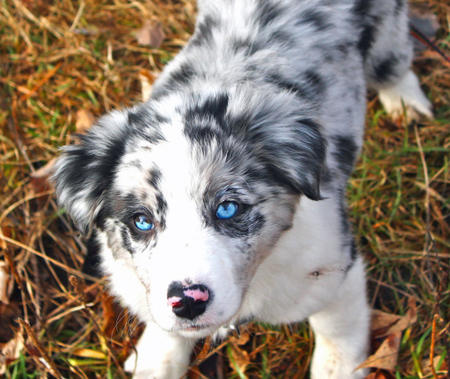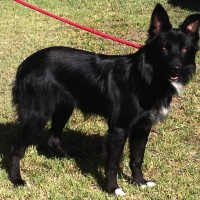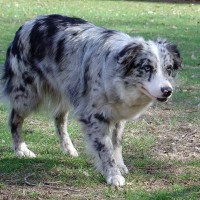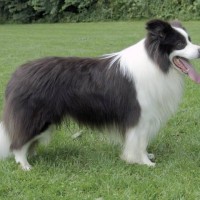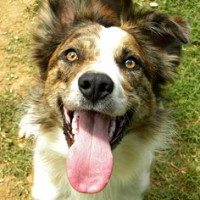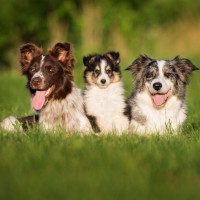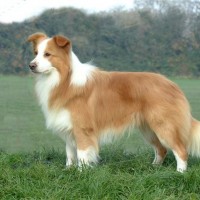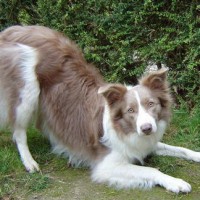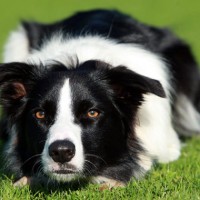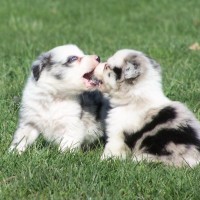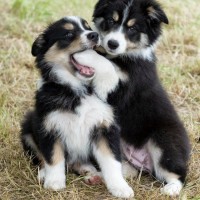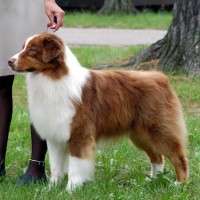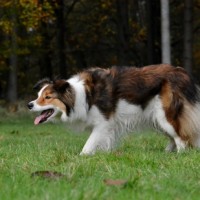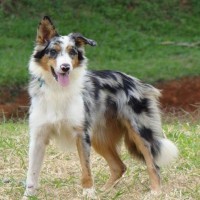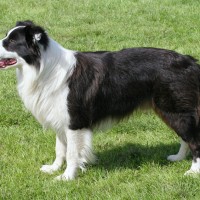Breed information
Group:
Herding
Life span: 12-15 years
Height male: 48-56 cm / 19-22 inches
Height female: 46-53 cm / 18-21 inches
Weight male: 14-20 kg / 30-45 pounds
Weight female: 12-19 kg / 27-42 pounds
Character: Intelligent, Energetic, Alert, Responsive, Tenacious, Loyal, Protective
History
The Border Collie is descended from landrace collies, a type found widely in the British Isles. The name for the breed came from its probable place of origin along the Anglo-Scottish border. Mention of the "Collie" or "Colley" type first appeared toward the end of the 19th century, although the word "collie" is older than this and has its origin in the Scots language. It is also thought that the word 'collie' comes from the old Celtic word for useful. Many of the best Border Collies today can be traced back to a dog known as Old Hemp. In 1915, James Reid, Secretary of the International Sheep Dog Society (ISDS) in the United Kingdom first used the term "Border Collie" to distinguish those dogs registered by the ISDS from the Kennel Club's Collie (or Scotch Collie, including the Rough Collie and Smooth Collie) which originally came from the same working stock but had developed a different, standardised appearance following introduction to the show ring in 1860 and mixture with different types breeds.
Old Hemp
Old Hemp, a tricolour dog, was born in Northumberland in September 1893 and died in May 1901. He was bred by Adam Telfer from Roy, a black and tan dog, and Meg, a black-coated, strong-eyed dog. Hemp was a quiet, powerful dog to which sheep responded easily. Many shepherds used him for stud and Hemp's working style became the Border Collie style. All pure Border Collies alive today can trace an ancestral line back to Old Hemp.
Wiston Cap
Wiston Cap (b. 28 September 1963) is the dog that the International Sheep Dog Society (ISDS) badge portrays in the characteristic Border Collie herding pose. He was a popular stud dog in the history of the breed, and his bloodline can be seen in most bloodlines of the modern day Collie. Bred by W. S. Hetherington and trained and handled by John Richardson, Cap was a biddable and good-natured dog. His bloodlines all trace back to the early registered dogs of the stud book, and to J. M. Wilson's Cap, whose name occurs 16 times within seven generations in his pedigree. Wiston Cap sired three Supreme Champions and is grand-sire of three others, one of whom was E. W. Edwards' Bill, who won the championship twice.
Introduction to New Zealand and Australia
Collies were listed as imports to New Zealand as early as 1858, but the type was not specified. In the late 1890s James Lilico of Christchurch, New Zealand, imported a number of working dogs from the United Kingdom. These included Hindhope Jed, a black, tan and white born in Hindhope, Scotland in 1895, as well as Maudie, Moss of Ancrum, Ness and Old Bob. It is unclear whether Hindhope Jed was a descendant of Old Hemp. Born two years after him, she is mentioned in a British Hunts and Huntsmen article concerning a Mr John Elliot of Jedburgh:
„Mr Elliot himself is well known for his breed of Collies. His father supplied Noble to the late Queen Victoria and it was from our subject that the McLeod got Hindhope Jed, now the champion of New Zealand and Australia.“
At the time of her departure to New Zealand, Hindhope Jed was already in pup to Captain, another of the then new "Border" strain. Hindhope Jed had won three trials in her native Scotland, and was considered to be the "best to cross the equator". In 1901 the King and Mcleod stud, created by Charles Beechworth King (b. 1855, Murrumbidgee, NSW), his brother and Alec McLeod at Canonbar, near Nyngan (north-west of Sydney), brought Hindhope Jed to Australia, where she enjoyed considerable success at sheep dog trials.
Description
The Border Collie is a well balanced, medium-sized dog of athletic appearance, displaying style and agility in equal measure with soundness and strength. Its hard, muscular body conveys the impression of effortless movement and endless endurance. The Border Collie is extremely intelligent, with its keen, alert expression being a very important characteristic of the breed. Any aspect of structure or temperament that would impede the dog's ability to function as a herding dog should be severely faulted. The Border Collie is, and should remain, a natural and unspoiled true working sheep dog whose conformation is described herein. Honorable scars and broken teeth incurred in the line of duty are acceptable.
Health
Collie eye anomaly (CEA) and epilepsy are considered the primary genetic diseases of concern in the breed at this time. CEA is a congenital, inherited eye disease involving the retina, choroid, and sclera that sometimes affects Border Collies. In Border Collies, it is generally a mild disease and rarely significantly impairs vision. However, other eye conditions such as PRA slowly disintegrates the retina and can cause Border Collies to lose almost all of their vision at night which can progress into complete daytime blindness. There is now a DNA test available for CEA and, through its use, breeders can ensure that they will not produce affected pups. There are different types of hip testing available including OFA (Orthopedic Foundation for Animals) and PennHip. Radiographs are taken and sent to these organizations to determine a dog's hip and elbow quality.
Two types of hearing loss occur in the breed. The first type is pigment associated and is found in Border Collie puppies, although the puppies can have congenital sensorineural deafness from birth as well. The second type is known as adult onset hearing loss. These dogs have a normal auditory brainstem response test as pups but gradually lose their hearing some time between one and eight years of age. A study is currently underway at The Translational Genomics Research Institute to identify the genetic cause of adult onset hearing loss in the breed.
Neuronal ceroid lipofuscinosis (NCL) is a rare but serious disease that is limited to show Border Collies. NCL results in severe neurological impairment and early death; afflicted dogs rarely survive beyond two years of age. The mutation causing the form of the disease found in Border Collies was identified by Scott Melville in the laboratory of Dr. Alan Wilton of the School of Biotechnology and Biomolecular Sciences, University of New South Wales. There is no treatment or cure, but a DNA test is now available to detect carriers as well as affected dogs.
Trapped Neutrophil Syndrome (TNS) is a hereditary disease in which the bone marrow produces neutrophils (white cells) but is unable to effectively release them into the bloodstream. Affected puppies have an impaired immune system and will eventually die from infections they cannot fight. The mutation responsible for TNS has been found in Border Collies in English working dogs, in show dogs that had originated in Australia and New Zealand, and in unrelated Australian working dogs. This indicates that the gene is widespread and probably as old as the breed itself. TNS was identified by Jeremy Shearman in the laboratory of Dr. Alan Wilton of the School of Biotechnology and Biomolecular Sciences, University of New South Wales. There is no cure, but a DNA test is now available to detect carriers as well as affected dogs.
Other diseases found less commonly include glaucoma, juvenile cataracts, osteochondritis, hypothyroidism, diabetes mellitus and canine cyclic neutropaenia, carpal soft-tissue injury. A syndrome of exercise induced collapse similar to that seen in Labrador Retrievers (otherwise termed Border Collie Collapse) and triggered by episodes of collapse associated with periods of intense exercise has been described in Border Collies in North America, Europe and Australia; and is currently the subject of further investigation.
Elbow dysplasia may also occur in the breed. Dogs homozygous for the merle gene, sometimes referred to as "double merles", are likely to have ocular and/or auditory defects.
Personality
Border Collies are famous frisbee and agility champions. With an intense, watchful eye they tackle every task put before them with the focus of an Olympic Athlete. Watching a Border Collie at work, whether in a field or on an agility course is truly breathtaking. They love to take on new tasks, and make the ideal dog for farmers and ranchers.
Activity Requirements
Border Collies are some of the most intelligent dogs in the world, and they need a lot of physical and mental activity. They can be a challenge for even the most seasoned dog owner. They must have at least two hours of activity a day in order to stave off behavioral problems, and the behavioral problems that develop in Border Collies can be severe. Apartment living won't do for this breed, a home with lots of room and time to run, play catch, chase balls and practice agility are a much better fit. Farms would be the most ideal setting for a Border Collie. Originally bred to tend flocks of sheep, they would spend hours a day running and herding and are their happiest when they are at work. Farmers are guaranteed a loyal, energetic “employee” when they adopt a Border Collie. If this breed does not have their physical and mental activity requirement met, they will develop anxiety and destructive behaviors. Many families are attracted to the breed because of their medium build and energy, but this energy can quickly become a problem if it is not channeled in the proper ways.
Trainability
Border Collies are problem-solvers and can be easily trained to do just about any task. Intelligent and observant, they can also pick up new behaviors without being taught – but usually behaviors that are unwanted such as opening cabinets, closets and doors, where they can get into mischief. Early training is essential with Border Collies. The earlier they learn to obey commands, the better. They like to be in charge and will take the opportunity to rule the roost, if given a little leeway. Positive reinforcement and a gentle but confident tone are needed when working with Border Collies. Their sensitive nature can cause them to shut down if they are treated with a heavy hand. This breed excels in agility and physical competition. Border Collies are often the champions of frisbee and long jump competitions, and thrive on this type of activity.
Best Training Equipment Trainers Recommend
Behavioral Traits
Border Collies are the Houdinis of the dog world. Mere fences can not keep them from escaping into the world. It is important to keep an eye on your Border Collie at all times. They have been known to jump, dig, even open the locks of fences to get out and explore. Early socialization and exposure to new experiences is very important, as Border Collies can be shy. If left unchecked, their reserved nature around strangers can change to aggression. They are often aggressive toward other animals, and cats or small pets should not be introduced into a Border Collie's home. Herding is in their blood and Border Collies have been known to try and herd groups of people at parties, children, other animals, bicycles and even cars. Never leave a Border Collie off a leash when in an open area, or they will take chase and nip at people. They can also be injured when running after bikes and cars. Separation anxiety is common in this breed, and can be severe. Because they need so much activity to stay happy, when they are bored and alone, anxiety sets I quickly. Border Collies will chew, bark, howl and dig when left alone for too long, unless they are properly exercised. Because they need so much exercise, it can be difficult to prevent severe anxiety.
Shedding
Border Collies are not high-maintenance in the grooming department. They shed lightly throughout the year and heavier during the change in seasons. Weekly brushing will keep shed hair from accumulating around the house and will also help distribute the natural oils in the dog's coat and prevent mats from forming. Unless a Border Collie likes to romp in the mud, baths are only needed once every few months. Weekly brushing of the teeth and cleaning of the ears can help keep harmful bacteria from growing and keep the dog healthy. Individuals with drop ears are especially prone to ear infections, and weekly cleanings with a veterinarian-recommended cleanser are essential.
